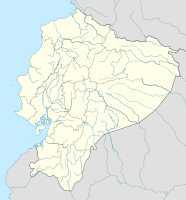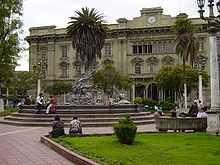Riobamba
| Riobamba | ||
|---|---|---|
|
Coordinates: 1° 40′ S , 78° 39′ W Riobamba on the map of Ecuador
|
||
| basic data | ||
| Country | Ecuador | |
| province | Chimborazo | |
| Canton | Riobamba | |
| city founding | August 15, 1534 | |
| resident | 146,324 (2010) | |
| city insignia | ||
| detail data | ||
| height | 2750 m | |
| city outline | 5 Parishes urbanas | |
| time zone | UTC −5 | |
| City Presidency | Napoleon Cadena Oleas (2014–2022) | |
| site | ||
Riobamba (full name San Pedro de Riobamba ) is a city in Ecuador . It is the capital of the Ecuadorian province of Chimborazo and the seat of the Bishop of Riobamba . It has 124,807 inhabitants (2004) and is the center of an agricultural region and an important transport hub in Ecuador.
geography
Riobamba is located in the Central Sierra at an altitude of 2750 meters in a basin of the Andes in the valley of the Río Chambo river . It is surrounded by the snow-capped and partly active volcanoes Chimborazo (6310 m), El Altar (5319 m), Carihuairazo (5020 m), Tungurahua (5023 m), Cubillín (4711 m) and Sangay (5230 m). Except for the Sangay, all of them can be seen from the city. Because of its location, Riobamba is also known as the "Sultan of the Andes" by locals.
story
Pre-Hispanic Period
The area around what is now Riobamba was the center of the Puruhá culture. The Puruhá were subdued by the Incas after lengthy battles. In the Riobamba area, Huayna Cápac probably created an important administrative and supply post for the Incas between Tomebamba (today Cuenca ), Latacunga and Quito . Strategically, the area was under the rule of the Incas, which was exercised from today's Quito.
Riobamba was probably founded by Rumiñahui , a general of the victorious Huayna Cápac succession war Atahualpa (a son of Huayna Cápac by his wife's only daughter of the last ruler of the Shyris), in retreat after his defeat by the troops of the Spanish conquistador Sebastian de Benalcazar destroyed. A little later, in August 1534, Belalcázar is said to have founded the towns of Santiago and San Francisco in the area around Riobamba , which were later moved to the north and west or newly founded and form Guayaquil and Quito today.
colonial era
Riobamba initially attracted little attention. In 1575 a place called San Pedro de Riobamba was re-established, which was primarily a military base under various names . Agriculture and animal husbandry on the surrounding fincas and haciendas, as well as textile manufactures, also allowed Riobamba's civilian importance to grow bit by bit, so that the city became an important market and cultural center in the 18th century.
On February 4, 1797, the city was almost completely destroyed by an earthquake, which also killed about half of the residents and large parts of the ruling class. In 1799 it was finally re-established about 15 kilometers to the north at its current location. On the site of the old Riobamba there is now the town of Cajabamba.
modern times
On April 21, 1822, Riobamba was declared independent of the Real Audiencia de Quito by the troops of the liberation fighter Antonio José de Sucre . It was henceforth part of Greater Colombia . Ecuador's first constitution was drawn up in Riobamba in August and September 1830, and with independence on September 23, the Venezuelan Juan José Flores was proclaimed the first president. One of the main streets of Riobamba is therefore today called Primera Constituyente .
In the second half of the 19th century, Riobamba became an administrative center and provincial capital with a Supreme Court. At the beginning of the 1860s, Pope Pius IX. set up the Bolívar Diocese based in Riobamba.
The construction of the railway line brought about a significant upswing at the beginning of the 20th century. The city became the third largest in the country. Numerous immigrants, including immigrants, settled here as traders. Magnificent buildings and suburbs emerged. On February 24, 1909, however, there was also a serious railway accident when a train derailed near the city after a track fault and fell 30 meters into the depths. 25 people died and 40 were injured.
In the mid-1920s, urban development lost momentum and stagnated for several decades. High numbers of emigrants to Quito, Guayaquil and abroad were and are the result, although the city's growth has increased significantly since the mid-1980s.
Culture and sights
buildings
Due to the destruction and re-establishment, Riobamba has comparatively few buildings worth seeing. The interior of the city's churches is largely unadorned. The cathedral is worth noting though: while its Españada (“Mestizo-Baroque”) façade is said to be reconstructed from the rubble of old Riobamba, the interior is more modern with concrete, glass and wood. A museum is attached to it.
The basilica in Parque La Libertad , built between 1883 and 1915, is considered the only round church in Ecuador.
On the Loma de Quito hill in the north of the city center is the Iglesia de San Antonio , built by Franciscans . From this hill you also have a particularly good view of the city and part of the surrounding volcanoes.
Museums
The Museum of Religious Art in the Iglesia de la Concepción church , belonging to the Convent of the Sisters of the Order of the Holy Conception, exhibits paintings, sculptures and other objects especially from the colonial period.
The Colegio Maldonado , which stands on the site of the Dominican convent where the Constituent Assembly met in 1830, houses a natural history museum.
natural monuments
Riobamba is the starting point for mountain hikes and mountaineering expeditions to the surrounding volcanoes. You can also see them from afar on the popular tourist train ride through the Andes from Riobamba via Alausí past the " Devil's Nose " to Huigra (and back). Not far from Riobamba is the Sangay National Park , which is a UNESCO World Heritage Site .
Economy and Infrastructure
The area, especially in the south and south-east of Riobamba, is an important agricultural center that supplies the large cities of Ecuador. Above all, vegetables (onions, potatoes, lentils, peas, beans, etc.) are grown, brought together in Riobamba and distributed throughout the country. There are also industrial companies, especially in the fields of textile , leather , wood and metal processing and ceramics . The arts and crafts trade mainly produces goods made of ceramics and corozo pulp .
According to a study by the Ecuadorian Statistical Institute (INEC) from 2004, Riobamba is the second best equipped city in Ecuador with municipal infrastructure after the small town of Sangolquí near Quito: 88.9% of households have running water, 96.4% are connected to the sewage system . 98.4% are connected to the electricity network and 53.3% to the telephone network. Garbage collection serves 93% of households. The security level is among the highest in the country.
traffic
Riobamba is a central point in Ecuador's transport network.
It lies between Quito and Cuenca on the Panamericana road that runs through the country in a north-south direction. In Riobamba it intersects and partially merges with another road that leads west to Guayaquil on the one hand and Tumbes in Peru via Machala on the Pacific coast on the other . This road runs to the east via Baños to Puyo and thus represents an important connection to the Amazon lowlands.
For the railway line from Guayaquíl-Durán to Quito of the Ecuadorian railways , Riobamba was an important station before the section to the coast was destroyed by landslides in 1998 and reduced in importance by bus traffic. However, trips from Riobamba (and sometimes from Quito) via Alausí to Huigra by train via the “ Devil's Nose ” continued to be offered to tourists. From 2009 to 2013, the rail network, which had been neglected for decades, was completely renovated , as well as the stations and the rolling stock. Since then, the rail route between Guayaquíl-Durán and Quito has been continuously usable again.
education
There are two regionally important universities in Riobamba , a general education Universidad Nacional and a polytechnic.
Sports
The football team Centro Deportivo Olmedo is based in the city .
sons and daughters of the town
- Pedro Vicente Maldonado (1704–1748), polymath, cartographer of Ecuador
- Juan de Velasco (1727–1792), Jesuit and historian
- Isabel Godin des Odonais (1728–1792), expeditionary traveler
- César Antonio Mosquera Corral (1896–1971), Archbishop of Guayaquil
- Carlos Mancheno (1902–1996), military and brief dictator
- Ernesto Alvarez Alvarez (1925–1991), Archbishop of Cuenca
- Luis Costales (1926–2006), writer and politician
- Raúl Eduardo Cardinal Vela Chiriboga (1934–2020), Roman Catholic Archbishop of Quito and Cardinal of the Catholic Church
- Bolívar Echeverría (1941–2010), cultural philosopher and writer
- Áureo Patricio Bonilla Bonilla (born 1968), clergyman, Vicar Apostolic of Galápagos
- Augusto Batioja (born 1990), soccer player
web links
- City Council website (Spanish)
- Los Andes newspaper website (Spanish)
- Homepage of the newspaper La Prensa (Spanish)
- Private site with photos and some information about Riobamba by Galen R. Frysinger
itemizations
- ↑ Peter WB Semmens: Disasters on rails. A worldwide documentary. Transpress, Stuttgart 1996, ISBN 3-344-71030-3 , p. 34.








